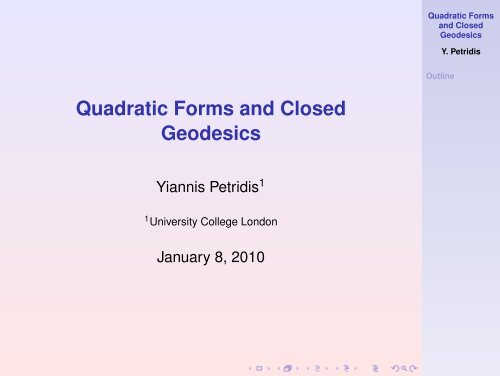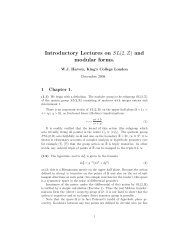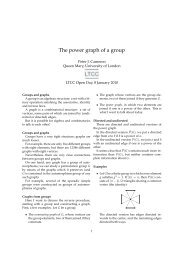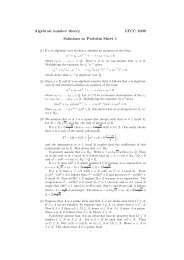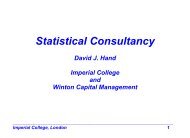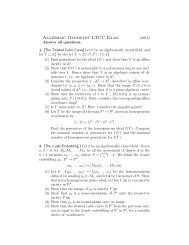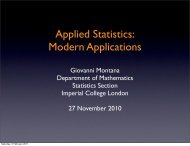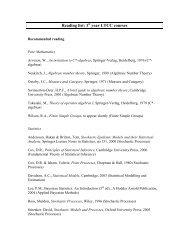Quadratic Forms and Closed Geodesics
Quadratic Forms and Closed Geodesics
Quadratic Forms and Closed Geodesics
Create successful ePaper yourself
Turn your PDF publications into a flip-book with our unique Google optimized e-Paper software.
<strong>Quadratic</strong> <strong>Forms</strong><br />
<strong>and</strong> <strong>Closed</strong><br />
<strong>Geodesics</strong><br />
Y. Petridis<br />
Outline<br />
<strong>Quadratic</strong> <strong>Forms</strong> <strong>and</strong> <strong>Closed</strong><br />
<strong>Geodesics</strong><br />
Yiannis Petridis 1<br />
1 University College London<br />
January 8, 2010
Outline<br />
<strong>Quadratic</strong> <strong>Forms</strong><br />
<strong>and</strong> <strong>Closed</strong><br />
<strong>Geodesics</strong><br />
Y. Petridis<br />
<strong>Quadratic</strong> <strong>Forms</strong><br />
<strong>Quadratic</strong> <strong>Forms</strong><br />
Hyperbolic surfaces<br />
Hyperbolic<br />
surfaces<br />
<strong>Closed</strong><br />
<strong>Geodesics</strong><br />
Spectral Theory<br />
<strong>Closed</strong> <strong>Geodesics</strong><br />
Spectral Theory
Pell’s Equation<br />
<strong>Quadratic</strong> <strong>Forms</strong><br />
<strong>and</strong> <strong>Closed</strong><br />
<strong>Geodesics</strong><br />
Y. Petridis<br />
◮ Algorithm for solving<br />
x 2 − 2y 2 = ±1<br />
(Pythagoreans)<br />
◮ Start with<br />
◮ We get<br />
x 1 = 1, y 1 = 1<br />
(x 2 , y 2 ) = (3, 2)<br />
(x 3 , y 3 ) = (7, 5)<br />
(x 4 , y 4 ) = (17, 12)<br />
◮ Recurrences<br />
x n+1 = x n + 2y n<br />
y n+1 = x n + y n<br />
◮ Fundamental solution:<br />
1 + √ 2<br />
x n + √ 2y n = (1 + √ 2) n<br />
<strong>Quadratic</strong> <strong>Forms</strong><br />
Hyperbolic<br />
surfaces<br />
<strong>Closed</strong><br />
<strong>Geodesics</strong><br />
Spectral Theory
Pell’s Equation<br />
<strong>Quadratic</strong> <strong>Forms</strong><br />
<strong>and</strong> <strong>Closed</strong><br />
<strong>Geodesics</strong><br />
Y. Petridis<br />
◮ Algorithm for solving<br />
x 2 − 2y 2 = ±1<br />
(Pythagoreans)<br />
◮ Start with<br />
◮ We get<br />
x 1 = 1, y 1 = 1<br />
(x 2 , y 2 ) = (3, 2)<br />
(x 3 , y 3 ) = (7, 5)<br />
(x 4 , y 4 ) = (17, 12)<br />
◮ Recurrences<br />
x n+1 = x n + 2y n<br />
y n+1 = x n + y n<br />
◮ Fundamental solution:<br />
1 + √ 2<br />
x n + √ 2y n = (1 + √ 2) n<br />
<strong>Quadratic</strong> <strong>Forms</strong><br />
Hyperbolic<br />
surfaces<br />
<strong>Closed</strong><br />
<strong>Geodesics</strong><br />
Spectral Theory
Pell’s Equation<br />
<strong>Quadratic</strong> <strong>Forms</strong><br />
<strong>and</strong> <strong>Closed</strong><br />
<strong>Geodesics</strong><br />
Y. Petridis<br />
◮ Algorithm for solving<br />
x 2 − 2y 2 = ±1<br />
(Pythagoreans)<br />
◮ Start with<br />
◮ We get<br />
x 1 = 1, y 1 = 1<br />
(x 2 , y 2 ) = (3, 2)<br />
(x 3 , y 3 ) = (7, 5)<br />
(x 4 , y 4 ) = (17, 12)<br />
◮ Recurrences<br />
x n+1 = x n + 2y n<br />
y n+1 = x n + y n<br />
◮ Fundamental solution:<br />
1 + √ 2<br />
x n + √ 2y n = (1 + √ 2) n<br />
<strong>Quadratic</strong> <strong>Forms</strong><br />
Hyperbolic<br />
surfaces<br />
<strong>Closed</strong><br />
<strong>Geodesics</strong><br />
Spectral Theory
Pell’s Equation<br />
<strong>Quadratic</strong> <strong>Forms</strong><br />
<strong>and</strong> <strong>Closed</strong><br />
<strong>Geodesics</strong><br />
Y. Petridis<br />
◮ Algorithm for solving<br />
x 2 − 2y 2 = ±1<br />
(Pythagoreans)<br />
◮ Start with<br />
◮ We get<br />
x 1 = 1, y 1 = 1<br />
(x 2 , y 2 ) = (3, 2)<br />
(x 3 , y 3 ) = (7, 5)<br />
(x 4 , y 4 ) = (17, 12)<br />
◮ Recurrences<br />
x n+1 = x n + 2y n<br />
y n+1 = x n + y n<br />
◮ Fundamental solution:<br />
1 + √ 2<br />
x n + √ 2y n = (1 + √ 2) n<br />
<strong>Quadratic</strong> <strong>Forms</strong><br />
Hyperbolic<br />
surfaces<br />
<strong>Closed</strong><br />
<strong>Geodesics</strong><br />
Spectral Theory
Pell’s Equation<br />
<strong>Quadratic</strong> <strong>Forms</strong><br />
<strong>and</strong> <strong>Closed</strong><br />
<strong>Geodesics</strong><br />
Y. Petridis<br />
◮ Algorithm for solving<br />
x 2 − 2y 2 = ±1<br />
(Pythagoreans)<br />
◮ Start with<br />
◮ We get<br />
x 1 = 1, y 1 = 1<br />
(x 2 , y 2 ) = (3, 2)<br />
(x 3 , y 3 ) = (7, 5)<br />
(x 4 , y 4 ) = (17, 12)<br />
◮ Recurrences<br />
x n+1 = x n + 2y n<br />
y n+1 = x n + y n<br />
◮ Fundamental solution:<br />
1 + √ 2<br />
x n + √ 2y n = (1 + √ 2) n<br />
<strong>Quadratic</strong> <strong>Forms</strong><br />
Hyperbolic<br />
surfaces<br />
<strong>Closed</strong><br />
<strong>Geodesics</strong><br />
Spectral Theory
Indefinite <strong>Quadratic</strong> <strong>Forms</strong><br />
◮ Q(x, y) = ax 2 + bxy + cy 2 , d = b 2 − 4ac > 0<br />
( ) t ( ) ( )<br />
x x a b/2<br />
◮ Q(x, y) = M M =<br />
y y<br />
b/2 c<br />
◮ Which integers are represented by Q, i.e.<br />
Q(x, y) = N,<br />
x, y, N ∈ N<br />
<strong>Quadratic</strong> <strong>Forms</strong><br />
<strong>and</strong> <strong>Closed</strong><br />
<strong>Geodesics</strong><br />
Y. Petridis<br />
<strong>Quadratic</strong> <strong>Forms</strong><br />
Hyperbolic<br />
surfaces<br />
<strong>Closed</strong><br />
<strong>Geodesics</strong><br />
Spectral Theory<br />
Equivalence of <strong>Quadratic</strong> <strong>Forms</strong><br />
Q ∼ Q ′ ⇒ they represent the same integers.<br />
( ) 0 −1<br />
◮ x 2 − 2y 2 ∼ −2x 2 + y 2 ◮ S =<br />
1 0<br />
◮ x 2 − 2y 2 ∼ x 2 + 2xy − y 2 ( ) 1 1<br />
T =<br />
0 1<br />
◮ (x + y) 2 − 2y 2 = x 2 + 2xy − y 2<br />
Q(x + y, y) = Q ′ (x, y) <strong>and</strong> Q ′ (x − y, y) = Q(x, y)
Indefinite <strong>Quadratic</strong> <strong>Forms</strong><br />
◮ Q(x, y) = ax 2 + bxy + cy 2 , d = b 2 − 4ac > 0<br />
( ) t ( ) ( )<br />
x x a b/2<br />
◮ Q(x, y) = M M =<br />
y y<br />
b/2 c<br />
◮ Which integers are represented by Q, i.e.<br />
Q(x, y) = N,<br />
x, y, N ∈ N<br />
<strong>Quadratic</strong> <strong>Forms</strong><br />
<strong>and</strong> <strong>Closed</strong><br />
<strong>Geodesics</strong><br />
Y. Petridis<br />
<strong>Quadratic</strong> <strong>Forms</strong><br />
Hyperbolic<br />
surfaces<br />
<strong>Closed</strong><br />
<strong>Geodesics</strong><br />
Spectral Theory<br />
Equivalence of <strong>Quadratic</strong> <strong>Forms</strong><br />
Q ∼ Q ′ ⇒ they represent the same integers.<br />
( ) 0 −1<br />
◮ x 2 − 2y 2 ∼ −2x 2 + y 2 ◮ S =<br />
1 0<br />
◮ x 2 − 2y 2 ∼ x 2 + 2xy − y 2 ( ) 1 1<br />
T =<br />
0 1<br />
◮ (x + y) 2 − 2y 2 = x 2 + 2xy − y 2<br />
Q(x + y, y) = Q ′ (x, y) <strong>and</strong> Q ′ (x − y, y) = Q(x, y)
Indefinite <strong>Quadratic</strong> <strong>Forms</strong><br />
◮ Q(x, y) = ax 2 + bxy + cy 2 , d = b 2 − 4ac > 0<br />
( ) t ( ) ( )<br />
x x a b/2<br />
◮ Q(x, y) = M M =<br />
y y<br />
b/2 c<br />
◮ Which integers are represented by Q, i.e.<br />
Q(x, y) = N,<br />
x, y, N ∈ N<br />
<strong>Quadratic</strong> <strong>Forms</strong><br />
<strong>and</strong> <strong>Closed</strong><br />
<strong>Geodesics</strong><br />
Y. Petridis<br />
<strong>Quadratic</strong> <strong>Forms</strong><br />
Hyperbolic<br />
surfaces<br />
<strong>Closed</strong><br />
<strong>Geodesics</strong><br />
Spectral Theory<br />
Equivalence of <strong>Quadratic</strong> <strong>Forms</strong><br />
Q ∼ Q ′ ⇒ they represent the same integers.<br />
( ) 0 −1<br />
◮ x 2 − 2y 2 ∼ −2x 2 + y 2 ◮ S =<br />
1 0<br />
◮ x 2 − 2y 2 ∼ x 2 + 2xy − y 2 ( ) 1 1<br />
T =<br />
0 1<br />
◮ (x + y) 2 − 2y 2 = x 2 + 2xy − y 2<br />
Q(x + y, y) = Q ′ (x, y) <strong>and</strong> Q ′ (x − y, y) = Q(x, y)
Indefinite <strong>Quadratic</strong> <strong>Forms</strong><br />
◮ Q(x, y) = ax 2 + bxy + cy 2 , d = b 2 − 4ac > 0<br />
( ) t ( ) ( )<br />
x x a b/2<br />
◮ Q(x, y) = M M =<br />
y y<br />
b/2 c<br />
◮ Which integers are represented by Q, i.e.<br />
Q(x, y) = N,<br />
x, y, N ∈ N<br />
<strong>Quadratic</strong> <strong>Forms</strong><br />
<strong>and</strong> <strong>Closed</strong><br />
<strong>Geodesics</strong><br />
Y. Petridis<br />
<strong>Quadratic</strong> <strong>Forms</strong><br />
Hyperbolic<br />
surfaces<br />
<strong>Closed</strong><br />
<strong>Geodesics</strong><br />
Spectral Theory<br />
Equivalence of <strong>Quadratic</strong> <strong>Forms</strong><br />
Q ∼ Q ′ ⇒ they represent the same integers.<br />
( ) 0 −1<br />
◮ x 2 − 2y 2 ∼ −2x 2 + y 2 ◮ S =<br />
1 0<br />
◮ x 2 − 2y 2 ∼ x 2 + 2xy − y 2 ( ) 1 1<br />
T =<br />
0 1<br />
◮ (x + y) 2 − 2y 2 = x 2 + 2xy − y 2<br />
Q(x + y, y) = Q ′ (x, y) <strong>and</strong> Q ′ (x − y, y) = Q(x, y)
Indefinite <strong>Quadratic</strong> <strong>Forms</strong><br />
◮ Q(x, y) = ax 2 + bxy + cy 2 , d = b 2 − 4ac > 0<br />
( ) t ( ) ( )<br />
x x a b/2<br />
◮ Q(x, y) = M M =<br />
y y<br />
b/2 c<br />
◮ Which integers are represented by Q, i.e.<br />
Q(x, y) = N,<br />
x, y, N ∈ N<br />
<strong>Quadratic</strong> <strong>Forms</strong><br />
<strong>and</strong> <strong>Closed</strong><br />
<strong>Geodesics</strong><br />
Y. Petridis<br />
<strong>Quadratic</strong> <strong>Forms</strong><br />
Hyperbolic<br />
surfaces<br />
<strong>Closed</strong><br />
<strong>Geodesics</strong><br />
Spectral Theory<br />
Equivalence of <strong>Quadratic</strong> <strong>Forms</strong><br />
Q ∼ Q ′ ⇒ they represent the same integers.<br />
( ) 0 −1<br />
◮ x 2 − 2y 2 ∼ −2x 2 + y 2 ◮ S =<br />
1 0<br />
◮ x 2 − 2y 2 ∼ x 2 + 2xy − y 2 ( ) 1 1<br />
T =<br />
0 1<br />
◮ (x + y) 2 − 2y 2 = x 2 + 2xy − y 2<br />
Q(x + y, y) = Q ′ (x, y) <strong>and</strong> Q ′ (x − y, y) = Q(x, y)
Indefinite <strong>Quadratic</strong> <strong>Forms</strong><br />
◮ Q(x, y) = ax 2 + bxy + cy 2 , d = b 2 − 4ac > 0<br />
( ) t ( ) ( )<br />
x x a b/2<br />
◮ Q(x, y) = M M =<br />
y y<br />
b/2 c<br />
◮ Which integers are represented by Q, i.e.<br />
Q(x, y) = N,<br />
x, y, N ∈ N<br />
<strong>Quadratic</strong> <strong>Forms</strong><br />
<strong>and</strong> <strong>Closed</strong><br />
<strong>Geodesics</strong><br />
Y. Petridis<br />
<strong>Quadratic</strong> <strong>Forms</strong><br />
Hyperbolic<br />
surfaces<br />
<strong>Closed</strong><br />
<strong>Geodesics</strong><br />
Spectral Theory<br />
Equivalence of <strong>Quadratic</strong> <strong>Forms</strong><br />
Q ∼ Q ′ ⇒ they represent the same integers.<br />
( ) 0 −1<br />
◮ x 2 − 2y 2 ∼ −2x 2 + y 2 ◮ S =<br />
1 0<br />
◮ x 2 − 2y 2 ∼ x 2 + 2xy − y 2 ( ) 1 1<br />
T =<br />
0 1<br />
◮ (x + y) 2 − 2y 2 = x 2 + 2xy − y 2<br />
Q(x + y, y) = Q ′ (x, y) <strong>and</strong> Q ′ (x − y, y) = Q(x, y)
Class Numbers<br />
h(d) = number of inequivalent forms of discriminant d.<br />
h(d) d=<br />
1 5, 8, 12, 13, 17, 21, 24, 28, 29, 33, 37, 41, 44, 53<br />
2 40, 60, 65, 85, 104, 105, 120, 136, 140, 156, 165<br />
3 229, 257, 316, 321, 469, 473, 568, 733, 761, 892<br />
4 145, 328, 445, 505, 520, 680, 689, 777, 780, 793<br />
5 401, 817, 1093, 1393, 1429, 1641, 1756, 1897, ...<br />
◮ D = {d|d > 0, d ≡ 0, 1 (mod 4), d ≠ □}<br />
◮ x 2 − dy 2 = 4, fundamental solution (t, u)<br />
ɛ d = t + u√ d<br />
2<br />
◮ Gauss, Siegel (1944)<br />
∑<br />
h(d) log ɛ d = π2 x 3/2<br />
+ O(x log x).<br />
18ζ(3)<br />
d∈D,d≤x<br />
ζ(s) =<br />
∞∑<br />
n=1<br />
1<br />
, R(s) > 1.<br />
ns <strong>Quadratic</strong> <strong>Forms</strong><br />
<strong>and</strong> <strong>Closed</strong><br />
<strong>Geodesics</strong><br />
Y. Petridis<br />
<strong>Quadratic</strong> <strong>Forms</strong><br />
Hyperbolic<br />
surfaces<br />
<strong>Closed</strong><br />
<strong>Geodesics</strong><br />
Spectral Theory
Class Numbers<br />
h(d) = number of inequivalent forms of discriminant d.<br />
h(d) d=<br />
1 5, 8, 12, 13, 17, 21, 24, 28, 29, 33, 37, 41, 44, 53<br />
2 40, 60, 65, 85, 104, 105, 120, 136, 140, 156, 165<br />
3 229, 257, 316, 321, 469, 473, 568, 733, 761, 892<br />
4 145, 328, 445, 505, 520, 680, 689, 777, 780, 793<br />
5 401, 817, 1093, 1393, 1429, 1641, 1756, 1897, ...<br />
◮ D = {d|d > 0, d ≡ 0, 1 (mod 4), d ≠ □}<br />
◮ x 2 − dy 2 = 4, fundamental solution (t, u)<br />
ɛ d = t + u√ d<br />
2<br />
◮ Gauss, Siegel (1944)<br />
∑<br />
h(d) log ɛ d = π2 x 3/2<br />
+ O(x log x).<br />
18ζ(3)<br />
d∈D,d≤x<br />
ζ(s) =<br />
∞∑<br />
n=1<br />
1<br />
, R(s) > 1.<br />
ns <strong>Quadratic</strong> <strong>Forms</strong><br />
<strong>and</strong> <strong>Closed</strong><br />
<strong>Geodesics</strong><br />
Y. Petridis<br />
<strong>Quadratic</strong> <strong>Forms</strong><br />
Hyperbolic<br />
surfaces<br />
<strong>Closed</strong><br />
<strong>Geodesics</strong><br />
Spectral Theory
Class Numbers<br />
h(d) = number of inequivalent forms of discriminant d.<br />
h(d) d=<br />
1 5, 8, 12, 13, 17, 21, 24, 28, 29, 33, 37, 41, 44, 53<br />
2 40, 60, 65, 85, 104, 105, 120, 136, 140, 156, 165<br />
3 229, 257, 316, 321, 469, 473, 568, 733, 761, 892<br />
4 145, 328, 445, 505, 520, 680, 689, 777, 780, 793<br />
5 401, 817, 1093, 1393, 1429, 1641, 1756, 1897, ...<br />
◮ D = {d|d > 0, d ≡ 0, 1 (mod 4), d ≠ □}<br />
◮ x 2 − dy 2 = 4, fundamental solution (t, u)<br />
ɛ d = t + u√ d<br />
2<br />
◮ Gauss, Siegel (1944)<br />
∑<br />
h(d) log ɛ d = π2 x 3/2<br />
+ O(x log x).<br />
18ζ(3)<br />
d∈D,d≤x<br />
ζ(s) =<br />
∞∑<br />
n=1<br />
1<br />
, R(s) > 1.<br />
ns <strong>Quadratic</strong> <strong>Forms</strong><br />
<strong>and</strong> <strong>Closed</strong><br />
<strong>Geodesics</strong><br />
Y. Petridis<br />
<strong>Quadratic</strong> <strong>Forms</strong><br />
Hyperbolic<br />
surfaces<br />
<strong>Closed</strong><br />
<strong>Geodesics</strong><br />
Spectral Theory
From <strong>Quadratic</strong> <strong>Forms</strong> to Hyperbolic<br />
Geometry<br />
Q(x, y) = ax 2 + bxy + cy 2<br />
az 2 + bz + c = 0 ⇔ z 1 = −b+√ d<br />
2a<br />
, z 2 = −b−√ d<br />
2a<br />
<strong>Quadratic</strong> <strong>Forms</strong><br />
<strong>and</strong> <strong>Closed</strong><br />
<strong>Geodesics</strong><br />
Y. Petridis<br />
<strong>Quadratic</strong> <strong>Forms</strong><br />
Hyperbolic<br />
surfaces<br />
<strong>Closed</strong><br />
<strong>Geodesics</strong><br />
Spectral Theory<br />
*<br />
(!b!d^(1/2))/2a<br />
x<br />
(!b+d^(1/2))/2a
From <strong>Quadratic</strong> <strong>Forms</strong> to Hyperbolic<br />
Geometry<br />
Q(x, y) = ax 2 + bxy + cy 2<br />
az 2 + bz + c = 0 ⇔ z 1 = −b+√ d<br />
2a<br />
, z 2 = −b−√ d<br />
2a<br />
<strong>Quadratic</strong> <strong>Forms</strong><br />
<strong>and</strong> <strong>Closed</strong><br />
<strong>Geodesics</strong><br />
Y. Petridis<br />
<strong>Quadratic</strong> <strong>Forms</strong><br />
Hyperbolic<br />
surfaces<br />
<strong>Closed</strong><br />
<strong>Geodesics</strong><br />
Spectral Theory<br />
(!b!d^(1/2))/2a<br />
x<br />
(!b+d^(1/2))/2a
Linear Fractional Transformations <strong>and</strong><br />
SL 2 (R)<br />
T (z) = az + b , ad − bc ≠ 0<br />
cz + d<br />
maps ( circles)<br />
to circles<br />
a b<br />
γ =<br />
→ T (z)<br />
c d<br />
{ ( a b<br />
SL 2 (R) = γ =<br />
c d<br />
acts on<br />
Upper-half space<br />
)<br />
}<br />
, ad − bc = 1<br />
H = {z = x + iy, y > 0} ds 2 = dx 2 + dy 2<br />
z(t) = x(t) + iy(t), t ∈ [a, b], L = ∫ b<br />
a<br />
◮ z → z + 1<br />
y<br />
√ 2<br />
x ′ (t) 2 +y ′ (t) 2<br />
y(t)<br />
dt<br />
<strong>Quadratic</strong> <strong>Forms</strong><br />
<strong>and</strong> <strong>Closed</strong><br />
<strong>Geodesics</strong><br />
Y. Petridis<br />
<strong>Quadratic</strong> <strong>Forms</strong><br />
Hyperbolic<br />
surfaces<br />
<strong>Closed</strong><br />
<strong>Geodesics</strong><br />
Spectral Theory<br />
◮ z → − 1 z<br />
Γ = SL 2 (Z) = {γ ∈ SL 2 (R), a, b, c, d ∈ Z}
The Hyperbolic Disc<br />
<strong>Quadratic</strong> <strong>Forms</strong><br />
<strong>and</strong> <strong>Closed</strong><br />
<strong>Geodesics</strong><br />
Y. Petridis<br />
<strong>Quadratic</strong> <strong>Forms</strong><br />
◮ Model of hyperbolic<br />
geometry<br />
H = {z = x + iy, |z| < 1}<br />
Hyperbolic<br />
surfaces<br />
<strong>Closed</strong><br />
<strong>Geodesics</strong><br />
Spectral Theory<br />
◮ Hyperbolic metric<br />
ds 2 =<br />
dx 2 + dy 2<br />
(1 − (x 2 + y 2 )) 2<br />
d(0, z) = ln 1 + |z|<br />
1 − |z| ,
<strong>Geodesics</strong> in Hyperbolic Disc<br />
<strong>Quadratic</strong> <strong>Forms</strong><br />
<strong>and</strong> <strong>Closed</strong><br />
<strong>Geodesics</strong><br />
Y. Petridis<br />
<strong>Quadratic</strong> <strong>Forms</strong><br />
Hyperbolic<br />
surfaces<br />
<strong>Closed</strong><br />
<strong>Geodesics</strong><br />
Spectral Theory<br />
◮ Semicircles perpendicular to<br />
boundary<br />
◮ Diameters
<strong>Geodesics</strong> in the Upper Half Plane<br />
<strong>Quadratic</strong> <strong>Forms</strong><br />
<strong>and</strong> <strong>Closed</strong><br />
<strong>Geodesics</strong><br />
Y. Petridis<br />
<strong>Quadratic</strong> <strong>Forms</strong><br />
Hyperbolic<br />
surfaces<br />
<strong>Closed</strong><br />
<strong>Geodesics</strong><br />
Spectral Theory<br />
(!b!d^(1/2))/2a<br />
x<br />
(!b+d^(1/2))/2a
Fundamental Domains<br />
z ∼ w ⇔ w = T (z), T ∈ Γ<br />
H/Γ the modular surface<br />
<strong>Quadratic</strong> <strong>Forms</strong><br />
<strong>and</strong> <strong>Closed</strong><br />
<strong>Geodesics</strong><br />
Y. Petridis<br />
<strong>Quadratic</strong> <strong>Forms</strong><br />
Hyperbolic<br />
surfaces<br />
<strong>Closed</strong><br />
<strong>Geodesics</strong><br />
Spectral Theory
Arithmetic subgroups of SL 2 (Z)<br />
Example<br />
Fundamental Domain for Γ 0 (6)<br />
<strong>Quadratic</strong> <strong>Forms</strong><br />
<strong>and</strong> <strong>Closed</strong><br />
<strong>Geodesics</strong><br />
Y. Petridis<br />
<strong>Quadratic</strong> <strong>Forms</strong><br />
Hyperbolic<br />
surfaces<br />
<strong>Closed</strong><br />
<strong>Geodesics</strong><br />
Spectral Theory<br />
Hecke subgroups Γ 0 (N)<br />
az + b<br />
cz + d ∈ SL 2(Z), N|c
¡<br />
Tesselations<br />
<strong>Quadratic</strong> <strong>Forms</strong><br />
<strong>and</strong> <strong>Closed</strong><br />
<strong>Geodesics</strong><br />
Y. Petridis<br />
<strong>Quadratic</strong> <strong>Forms</strong><br />
Hyperbolic<br />
surfaces<br />
T 1 F<br />
F<br />
TF<br />
<strong>Closed</strong><br />
<strong>Geodesics</strong><br />
Spectral Theory<br />
T 1 JF<br />
JF<br />
T JF<br />
T 2 UTF<br />
T 1 U 2 F<br />
T 1 UTF<br />
U 2 F<br />
UTF<br />
TU 2 F<br />
1<br />
0 1<br />
1<br />
Figure: Translates of the<br />
fundamental domain of<br />
SL 2 (Z)<br />
Figure: Triangles in the<br />
disc
Equivalence of <strong>Quadratic</strong> forms <strong>and</strong><br />
SL 2 (R)<br />
Q ′ ∼ Q ⇔ M ′ = γ t Mγ, γ ∈ Γ.<br />
Q → g =<br />
( t−bu<br />
)<br />
2<br />
−cu<br />
∈ Γ<br />
au<br />
t+bu<br />
2<br />
where t 2 − du 2 = 4 <strong>and</strong> (t, u) is the fundamental<br />
(smallest solution).<br />
Remarks: 1. g has eigenvalue ɛ d = t + u√ d<br />
2<br />
2. Most g ∈ SL 2 (R) can be diagonalised<br />
g ∼<br />
( N(g)<br />
1/2<br />
0<br />
0 N(g) −1/2 )<br />
.<br />
<strong>Quadratic</strong> <strong>Forms</strong><br />
<strong>and</strong> <strong>Closed</strong><br />
<strong>Geodesics</strong><br />
Y. Petridis<br />
<strong>Quadratic</strong> <strong>Forms</strong><br />
Hyperbolic<br />
surfaces<br />
<strong>Closed</strong><br />
<strong>Geodesics</strong><br />
Spectral Theory
Pell’s Equation <strong>and</strong> Lengths of <strong>Closed</strong><br />
<strong>Geodesics</strong><br />
<strong>Quadratic</strong> <strong>Forms</strong><br />
<strong>and</strong> <strong>Closed</strong><br />
<strong>Geodesics</strong><br />
Y. Petridis<br />
<strong>Quadratic</strong> <strong>Forms</strong><br />
Hyperbolic<br />
surfaces<br />
N(g)<br />
1<br />
∫ N(g)<br />
1<br />
1<br />
y dy = ln N(g) = ln(ɛ2 d )<br />
<strong>Closed</strong><br />
<strong>Geodesics</strong><br />
Spectral Theory<br />
x<br />
1<br />
N(g)<br />
Theorem<br />
The lengths of the closed geodesics for the hyperbolic<br />
surface H/SL 2 (Z) are 2 log ɛ d with multiplicity h(d),<br />
d ∈ D.
Distribution <strong>Closed</strong> geodesics of H/Γ<br />
<strong>Quadratic</strong> <strong>Forms</strong><br />
<strong>and</strong> <strong>Closed</strong><br />
<strong>Geodesics</strong><br />
Y. Petridis<br />
<strong>Closed</strong> geodesics γ.<br />
Prime Geodesic Theorem Prime Number Theorem<br />
◮ π(x) = {γ, length (γ) ≤ ln x}<br />
π(x) ∼<br />
x<br />
◮ π(x) = {p prime, p ≤ x}<br />
ln x , x → ∞ π(x) ∼<br />
x<br />
ln x , x → ∞<br />
◮ Class number distribution (Sarnak, 1982)<br />
∑<br />
d∈D,ɛ d ≤x<br />
h(d) ∼ x 2<br />
2 ln x<br />
<strong>Quadratic</strong> <strong>Forms</strong><br />
Hyperbolic<br />
surfaces<br />
<strong>Closed</strong><br />
<strong>Geodesics</strong><br />
Spectral Theory
Distribution <strong>Closed</strong> geodesics of H/Γ<br />
<strong>Quadratic</strong> <strong>Forms</strong><br />
<strong>and</strong> <strong>Closed</strong><br />
<strong>Geodesics</strong><br />
Y. Petridis<br />
<strong>Closed</strong> geodesics γ.<br />
Prime Geodesic Theorem Prime Number Theorem<br />
◮ π(x) = {γ, length (γ) ≤ ln x}<br />
π(x) ∼<br />
x<br />
◮ π(x) = {p prime, p ≤ x}<br />
ln x , x → ∞ π(x) ∼<br />
x<br />
ln x , x → ∞<br />
◮ Class number distribution (Sarnak, 1982)<br />
∑<br />
d∈D,ɛ d ≤x<br />
h(d) ∼ x 2<br />
2 ln x<br />
<strong>Quadratic</strong> <strong>Forms</strong><br />
Hyperbolic<br />
surfaces<br />
<strong>Closed</strong><br />
<strong>Geodesics</strong><br />
Spectral Theory
Distribution <strong>Closed</strong> geodesics of H/Γ<br />
<strong>Quadratic</strong> <strong>Forms</strong><br />
<strong>and</strong> <strong>Closed</strong><br />
<strong>Geodesics</strong><br />
Y. Petridis<br />
<strong>Closed</strong> geodesics γ.<br />
Prime Geodesic Theorem Prime Number Theorem<br />
◮ π(x) = {γ, length (γ) ≤ ln x}<br />
π(x) ∼<br />
x<br />
◮ π(x) = {p prime, p ≤ x}<br />
ln x , x → ∞ π(x) ∼<br />
x<br />
ln x , x → ∞<br />
◮ Class number distribution (Sarnak, 1982)<br />
∑<br />
d∈D,ɛ d ≤x<br />
h(d) ∼ x 2<br />
2 ln x<br />
<strong>Quadratic</strong> <strong>Forms</strong><br />
Hyperbolic<br />
surfaces<br />
<strong>Closed</strong><br />
<strong>Geodesics</strong><br />
Spectral Theory
The Laplace Operator<br />
<strong>Quadratic</strong> <strong>Forms</strong><br />
<strong>and</strong> <strong>Closed</strong><br />
<strong>Geodesics</strong><br />
Y. Petridis<br />
<strong>Quadratic</strong> <strong>Forms</strong><br />
( )<br />
∂<br />
∆ = −y 2 2<br />
∂x 2 + ∂2<br />
∂y 2<br />
∆f = 0 ⇔ f is harmonic<br />
Eigenvalue problem: Solve<br />
Hyperbolic<br />
surfaces<br />
<strong>Closed</strong><br />
<strong>Geodesics</strong><br />
Spectral Theory<br />
∆f = λf<br />
Infinite Matrix, no determinant to compute eigenvalues.<br />
I require f (γz) = f (z), γ ∈ Γ (automorphic form)
Contour plots of eigenfunctions of H/Γ 0 (7)<br />
<strong>Quadratic</strong> <strong>Forms</strong><br />
<strong>and</strong> <strong>Closed</strong><br />
<strong>Geodesics</strong><br />
Y. Petridis<br />
<strong>Quadratic</strong> <strong>Forms</strong><br />
Hyperbolic<br />
surfaces<br />
<strong>Closed</strong><br />
<strong>Geodesics</strong><br />
Spectral Theory<br />
Figure: λ = 37.08033 λ = 692.7292
Contour plots of eigenfunctions of H/Γ 0 (3)<br />
<strong>Quadratic</strong> <strong>Forms</strong><br />
<strong>and</strong> <strong>Closed</strong><br />
<strong>Geodesics</strong><br />
Y. Petridis<br />
<strong>Quadratic</strong> <strong>Forms</strong><br />
Hyperbolic<br />
surfaces<br />
<strong>Closed</strong><br />
<strong>Geodesics</strong><br />
Spectral Theory<br />
Figure: λ = 26.3467 λ = 60.4397
The Riemann Hypothesis<br />
◮ Think of<br />
∞∑<br />
n=0<br />
z n = 1<br />
1 − z .<br />
Series: |z| < 1, 1/(1 − z), z ≠ 1.<br />
∞∑ 1<br />
◮ ζ(s) = ,<br />
ns R(s) > 1.<br />
n=1<br />
Extend to 1/2 ≤ R(s), then to C using functional<br />
equation<br />
<strong>Quadratic</strong> <strong>Forms</strong><br />
<strong>and</strong> <strong>Closed</strong><br />
<strong>Geodesics</strong><br />
Y. Petridis<br />
<strong>Quadratic</strong> <strong>Forms</strong><br />
Hyperbolic<br />
surfaces<br />
<strong>Closed</strong><br />
<strong>Geodesics</strong><br />
Spectral Theory<br />
−1+s Γ((1 − s)/2)<br />
ζ(s) = π ζ(1 − s).<br />
Γ(s/2)<br />
Zeros: ρ, 1 − ρ symmetric around R(s) = 1/2.<br />
Riemann Hypothesis<br />
R(ρ) = 1/2 ALWAYS
The Riemann Hypothesis<br />
◮ Think of<br />
∞∑<br />
n=0<br />
z n = 1<br />
1 − z .<br />
Series: |z| < 1, 1/(1 − z), z ≠ 1.<br />
∞∑ 1<br />
◮ ζ(s) = ,<br />
ns R(s) > 1.<br />
n=1<br />
Extend to 1/2 ≤ R(s), then to C using functional<br />
equation<br />
<strong>Quadratic</strong> <strong>Forms</strong><br />
<strong>and</strong> <strong>Closed</strong><br />
<strong>Geodesics</strong><br />
Y. Petridis<br />
<strong>Quadratic</strong> <strong>Forms</strong><br />
Hyperbolic<br />
surfaces<br />
<strong>Closed</strong><br />
<strong>Geodesics</strong><br />
Spectral Theory<br />
−1+s Γ((1 − s)/2)<br />
ζ(s) = π ζ(1 − s).<br />
Γ(s/2)<br />
Zeros: ρ, 1 − ρ symmetric around R(s) = 1/2.<br />
Riemann Hypothesis<br />
R(ρ) = 1/2 ALWAYS
The Riemann Hypothesis<br />
◮ Think of<br />
∞∑<br />
n=0<br />
z n = 1<br />
1 − z .<br />
Series: |z| < 1, 1/(1 − z), z ≠ 1.<br />
∞∑ 1<br />
◮ ζ(s) = ,<br />
ns R(s) > 1.<br />
n=1<br />
Extend to 1/2 ≤ R(s), then to C using functional<br />
equation<br />
<strong>Quadratic</strong> <strong>Forms</strong><br />
<strong>and</strong> <strong>Closed</strong><br />
<strong>Geodesics</strong><br />
Y. Petridis<br />
<strong>Quadratic</strong> <strong>Forms</strong><br />
Hyperbolic<br />
surfaces<br />
<strong>Closed</strong><br />
<strong>Geodesics</strong><br />
Spectral Theory<br />
−1+s Γ((1 − s)/2)<br />
ζ(s) = π ζ(1 − s).<br />
Γ(s/2)<br />
Zeros: ρ, 1 − ρ symmetric around R(s) = 1/2.<br />
Riemann Hypothesis<br />
R(ρ) = 1/2 ALWAYS
Relations of RH with spectral theory<br />
Scattering of waves on H/Γ<br />
<strong>Quadratic</strong> <strong>Forms</strong><br />
<strong>and</strong> <strong>Closed</strong><br />
<strong>Geodesics</strong><br />
Y. Petridis<br />
<strong>Quadratic</strong> <strong>Forms</strong><br />
Hyperbolic<br />
surfaces<br />
<strong>Closed</strong><br />
<strong>Geodesics</strong><br />
Spectral Theory<br />
φ(s) = √ π<br />
Γ(s − 1/2)ζ(2s − 1)<br />
Γ(s)ζ(2s)<br />
Poles of φ(s) at ρ/2.<br />
RH⇔Poles of φ(s), have real part 1/4.
Duality between periods <strong>and</strong> eigenvalues<br />
Physical background Hyperbolic manifolds Eigenfunctions Periodic orbits Free groups<br />
Duality between periods <strong>and</strong> eigenvalues<br />
<strong>Quadratic</strong> <strong>Forms</strong><br />
<strong>and</strong> <strong>Closed</strong><br />
<strong>Geodesics</strong><br />
Y. Petridis<br />
<strong>Quadratic</strong> <strong>Forms</strong><br />
Hyperbolic<br />
surfaces<br />
<strong>Closed</strong><br />
<strong>Geodesics</strong><br />
Spectral Theory<br />
Periods<br />
Eigenvalues
Duality between periods <strong>and</strong> eigenvalues<br />
Physical background Hyperbolic manifolds Eigenfunctions Periodic orbits Free groups<br />
Duality between periods <strong>and</strong> eigenvalues<br />
<strong>Quadratic</strong> <strong>Forms</strong><br />
<strong>and</strong> <strong>Closed</strong><br />
<strong>Geodesics</strong><br />
Y. Petridis<br />
<strong>Quadratic</strong> <strong>Forms</strong><br />
Hyperbolic<br />
surfaces<br />
<strong>Closed</strong><br />
<strong>Geodesics</strong><br />
Spectral Theory<br />
Periods<br />
Trace Formulae<br />
Eigenvalues
Duality between periods <strong>and</strong> eigenvalues<br />
Physical background Hyperbolic manifolds Eigenfunctions Periodic orbits Free groups<br />
Duality between periods <strong>and</strong> eigenvalues<br />
<strong>Quadratic</strong> <strong>Forms</strong><br />
<strong>and</strong> <strong>Closed</strong><br />
<strong>Geodesics</strong><br />
Y. Petridis<br />
<strong>Quadratic</strong> <strong>Forms</strong><br />
Hyperbolic<br />
surfaces<br />
<strong>Closed</strong><br />
<strong>Geodesics</strong><br />
Spectral Theory<br />
Periods<br />
Trace Formulae<br />
Eigenvalues<br />
Lengths of closed<br />
geodesics<br />
Selberg Trace formula<br />
Laplace eigenvalues
Simple trace formula<br />
<strong>Quadratic</strong> <strong>Forms</strong><br />
<strong>and</strong> <strong>Closed</strong><br />
<strong>Geodesics</strong><br />
Y. Petridis<br />
<strong>Quadratic</strong> <strong>Forms</strong><br />
Hyperbolic<br />
surfaces<br />
<strong>Closed</strong><br />
<strong>Geodesics</strong><br />
n∑<br />
Tr(A) = a ii =<br />
n∑<br />
i=1 j=1<br />
What is <strong>and</strong> how do I compute the trace of an operator?<br />
λ j<br />
Spectral Theory
Credits for the pictures<br />
1. V. Golovshanski, N. Motrov: preprint, Inst. Appl.<br />
Math. Khabarovsk (1982)<br />
2. D. Hejhal, B. Rackner: On the topography of Maass<br />
waveforms for PSL(2, Z ). Experiment. Math. 1<br />
(1992), no. 4, 275–305.<br />
3. A. Krieg: http://www.matha.rwthaachen.de/forschung/fundamentalbereich.html<br />
4. http://mathworld.wolfram.com/<br />
5. F. Stromberg:<br />
http://www.math.uu.se/ fredrik/research/gallery/<br />
6. H. Verrill: http://www.math.lsu.edu/ verrill/<br />
<strong>Quadratic</strong> <strong>Forms</strong><br />
<strong>and</strong> <strong>Closed</strong><br />
<strong>Geodesics</strong><br />
Y. Petridis<br />
<strong>Quadratic</strong> <strong>Forms</strong><br />
Hyperbolic<br />
surfaces<br />
<strong>Closed</strong><br />
<strong>Geodesics</strong><br />
Spectral Theory


